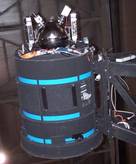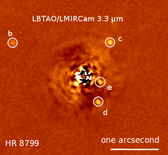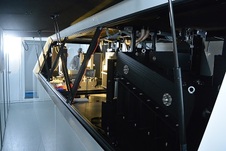Instruments Overview
The instruments and observing modes available for the upcoming semester are described on the Science Operations Web Pages.

LBC Red - LBC Blue
The Large Binocular Cameras (LBC) are two wide-field cameras mounted on the prime focus swing arms of LBT. LBC Blue is blue-optimized for observations from approximately 3500 to 6500 angstroms, while LBC Red is is red-optimized for observations from approximately 5500 angstroms to 1 micron. The LBCs are used simultaneously (binocular mode).
The LBC focal plane consists of four EEV42-90 CCDs (2048 x 4608 pixels, 13.5 microns x 13.5 microns per pixel). The focal plane scale is 16.9 arcsec/mm, and, thus, the average pixel scale for both LBC Blue and LBC Red is 0.2255 arcsec/pixel. Each CCD covers approximately 7.8 arcmin x 17.6 arcmin, with gaps between the chips of ~18 arcseconds (70 pixels). The science field of view is approximately 23 arcmin x 25 arcmin.
MODS1 - MODS2
MODS1 and MODS2 are a pair of matched low- to medium-resolution Multi-Object Double CCD Spectrographs/Imagers. The MODS are two identical two-channel spectrographs, one for each of the direct f/15 Gregorian foci of the LBT. Each MODS is a seeing-limited spectrograph and imager working in the 320-1100nm wavelength range with a 6×6-arcminute field of view. Gratings provide a spectral resolution of R~2000 and double-pass prisms provide a low-resolution (R=500-150) faint-object mode. Multi-object spectroscopy is accomplished using laser-machined focal-plane slit masks fed into the beam from a 24-position mask cassette. A beam selector below the slit carries a dichroic that splits the incoming beam into separate red- and blue-optimized channels at a wavelength of 565nm.


LUCI1 - LUCI2
LUCI 1 and LUCI2 are a pair of infrared multi-mode instruments. In seeing-limited mode, each has a 4 arc-minute square field of view and will be capable of long-slit and multi-slit spectroscopy as well as imaging in the near infrared zJHK bands from 0.89 (LUCI1) or 0.96 (LUCI2) to 2.44 microns. Each instrument includes diffraction-limited optics covering a 30-arcsecond field of view for use with the adaptive secondary mirrors. In seeing limited mode, the image scale is 0.12″/pix (N3.75 camera) for imaging and 0.25 “/pix (N1.8 camera) for spectroscopy. With the N30 camera in AO mode, it is 0.015 “/pixel. Laser-cut slit masks reside in a jukebox inside the instrument cryostat. Various gratings provide resolutions from ~2000 for H+K to 6500-8500 in single band z,j,H,K in the basic modes.
LMIRcam on LBTI
LMIRcam is a camera and coronagraph built to exploit the unique sensitivity and resolution of the LBT Interferometer. LMIIRcam is available in three modes: (1) Single and dual aperture non-coherent (direct) imaging – (2) Single and Dual aperture nonredundant mask imaging. – (3) Single aperture apodizing phase plate coronagraphy.
The LMIRcam detector is a Teledyne H2RG device with sensitivity from 1-5 µm wavelength. The current electronics only enables the readout of a quarter of the array. The field of view is ~11″x11″ with a pixel scale of 10.7mas/pixel. While optimized for 3-5 µm, LMIRcam can be sued at shorter wavelengths.


PEPSI
Current status of the facility instrumentation suite at the Large Binocular Telescope Observatory
Barry Rothberg, Jennifer Power, Olga Kuhn, David Thompson, John M. Hill, R. Mark Wagner, Christian Veillet
Proc. SPIE 11447, Groundbased and Airborne Instrumentation for Astronomy VIII, 1144706 (13 December 2020);
Copyright 2020 Society of Photo Optical Instrumentation Engineers. One print or electronic copy may be made for personal use only. Systematic reproduction and distribution, duplication of any material in this paper for a fee or for commercial purposes, or modification of the content of the paper are prohibited.
doi: 10.1117/12.2563352

